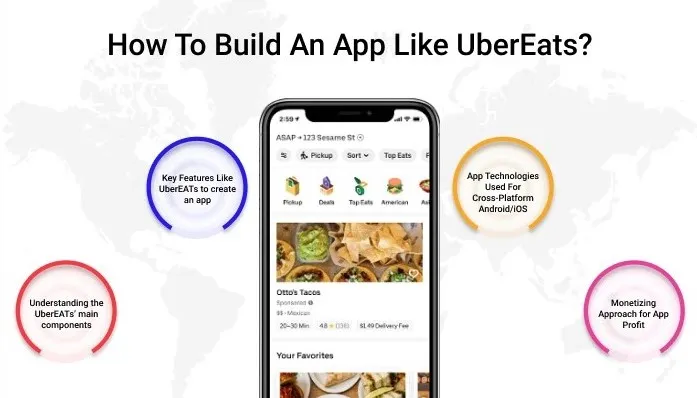The food service sector has seen explosive growth in the past few years, driven by the increasing demand for effortless on-demand services. With platforms such as UberEats and DoorDash transforming the way people request meals, the emphasis has shifted to developing innovative food delivery apps. These apps provide users the option to order food from their preferred restaurants and have it brought right to their doorstep. For companies, the challenge is to utilize technology to enhance delivery operations and ensure a smooth customer experience.
Building the Perfect Food Delivery App
Developing a successful food delivery app demands a thorough understanding of the industry shifts and business models that lead the industry. Whether building a full-stack delivery solution or concentrating on niche areas like virtual restaurants or cloud kitchens, the app’s functionality must to cater to both customers and restaurants. Key features such as real-time order monitoring, delivery time optimization, and user satisfaction metrics hold a critical role in guaranteeing customer loyalty.
Restaurant Delivery Partnerships: A Winning Strategy
Restaurants are increasingly establishing partnerships with delivery platforms to increase their customer reach. These agreements help restaurants provide to a larger audience while minimizing the obstacles of running their in-house delivery operations. The effectiveness of such collaborations hinges upon technology integration, which boosts the user interface design and enhances the customer experience. Through these partnerships, restaurants can boost brand loyalty and ensure that they stay competitive in a saturated market.
How KPIs Drive Food Delivery Profitability
For any business, knowing its performance metrics is crucial to ensuring profitability. In the food delivery sector, KPIs such as delivery time, order accuracy, and user happiness are essential. Tracking and improving these KPIs allows delivery services to offer a better customer experience. Additionally, keeping an focus on profitability helps companies optimize operations, reduce charges, and increase overall efficiency.
Customer Satisfaction and User Retention Strategies
A significant element in the success of delivery apps is their capacity to retain users through outstanding customer service. Offering fast food delivery and resolving customer reviews quickly can assist companies enhance their service offerings. Moreover, introducing loyalty programs and offering incentives like no-cost delivery can increase user retention. User happiness can be additionally bolstered by ensuring quality assurance and offering a seamless processing system.
The Role of Technology in Food Delivery
Technology is at the heart of modern food delivery services, helping companies optimize their operations and deliver a seamless customer experience. From mobile app development to real-time delivery tracking systems, Mobile App Development Trends for Food Delivery technology has a significant role in the success of delivery platforms. The use of data analytics to analyze user profiles and preferences enables delivery services to offer customized experiences, furthermore enhancing customer interaction.
Competitive Analysis in the Food Delivery Market
The food delivery market is highly competitive, with many players competing for market share. Conducting a market evaluation allows companies to assess their position in the market and spot chances for growth. Delivery platforms must differentiate themselves by offering distinctive features such as virtual restaurant options, quick service, or specialized cuisine options. Understanding market share and customer actions empowers companies to tailor their services and stay ahead of the competition.
The Impact of the Pandemic on Food Delivery Services
The COVID-19 pandemic has had a substantial impact See More on the delivery services, accelerating its growth as consumers opted for delivery services due to social distancing measures. The shift has highlighted the necessity of technological evolution in the food industry, with restaurants quickly adopting e-commerce platforms and delivery apps. As the world adjusts to new routines, food delivery businesses must continue innovating to meet changing consumer demands and ensure business growth.
Investing in Food Delivery Startups
The delivery sector presents plenty of entrepreneurial chances, with investors eager to backing companies that offer innovative solutions. From creating UberEats clones to building niche delivery apps, business owners have a range of paths to explore. Investors look for strong business models and the ability to scale, particularly in areas like system efficiency, customer interface, and technological advancement. By concentrating on these sectors, startups can secure substantial investments and gain a foothold in the market.
Enhancing Food Delivery Service Profitability and Expansion
Expanding a food delivery service requires a strong foundation built on customer acquisition, pricing strategies, and service differentiation. As local delivery services grow, businesses must focus on creating a reliable delivery network and maintaining food safety. Furthermore, widening the menu options, forming new collaborations, and adopting advanced tech solutions in food delivery will drive further growth. By constantly optimizing delivery times and ensuring high user happiness, companies can sustain a competitive edge and boost income streams.
These themes provide a complete understanding of the service landscape, with a focus on key aspects that drive the market forward. Whether whether you are a new company or an experienced business, concentrating on these factors will assist you thrive in the challenging world of food delivery.
